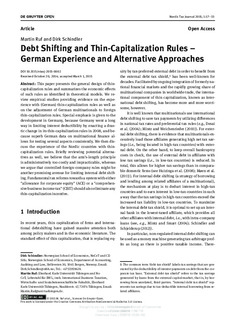Debt Shifting and Thin-Capitalization Rules – German Experience and Alternative Approaches
Journal article, Peer reviewed
Permanent lenke
http://hdl.handle.net/11250/2405002Utgivelsesdato
2015Metadata
Vis full innførselSamlinger
- Articles (FOR) [100]
- Publikasjoner fra CRIStin (NHH) [249]
Sammendrag
This paper presents the general design of thin-capitalization rules and summarizes the economic effects of such rules as identified in theoretical models. We review empirical studies providing evidence on the experience with (German) thin-capitalization rules as well as on the adjustment of German multinationals to foreign thin-capitalization rules. Special emphasis is given to the
development in Germany, because Germany went a long way in limiting interest deductibility by enacting a drastic change in its thin-capitalization rules in 2008, and because superb German data on multinational finance allows for testing several aspects consistently. We then discuss the experience of the Nordic countries with thin capitalization rules. Briefly reviewing potential alternatives as well, we believe that the arm’s-length principle is administratively too costly and impracticable, whereas we argue that controlled-foreign-company rules might be
another promising avenue for limiting internal debt shifting. Fundamental tax reforms towards a system with either "allowance for corporate equity" (ACE) or a "comprehensive business income tax" (CBIT) should also eliminate anythin-capitalization incentive.
Beskrivelse
This work is licensed under the Creative Commons Attribution-NonCommercial-NoDerivs 3.0 Licence.

